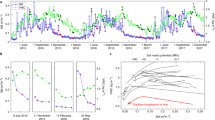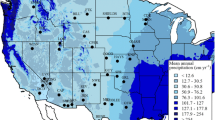Abstract
In arid/semi-arid ecosystems, biological resources, such as water, soil nutrients, and plant biomass, typically go through periods of high and low abundance. Short periods of high resource abundance are usually triggered by rainfall events, which, despite of the overall scarcity of rain, can saturate the resource demand of some biological processes for a time. This review develops the idea that there exists a hierarchy of soil moisture pulse events with a corresponding hierarchy of ecological responses, such that small pulses only trigger a small number of relatively minor ecological events, and larger pulses trigger a more inclusive set and some larger ecological events. This framework hinges on the observation that many biological state changes, where organisms transition from a state of lower to higher physiological activity, require a minimal triggering event size. Response thresholds are often determined by the ability of organisms to utilize soil moisture pulses of different infiltration depth or duration. For example, brief, shallow pulses can only affect surface dwelling organisms with fast response times and high tolerance for low resource levels, such as some species of the soil micro-fauna and -flora, while it takes more water and deeper infiltration to affect the physiology, growth or reproduction of higher plants. This review first discusses how precipitation, climate and site factors translate into soil moisture pulses of varying magnitude and duration. Next, the idea of the response hierarchy for ecosystem processes is developed, followed by an exploration of the possible evolutionary background for the existence of response thresholds to resource pulses. The review concludes with an outlook on global change: does the hierarchical view of precipitation effects in ecosystems provide new perspectives on the future of arid/semiarid lands?






Similar content being viewed by others
References
Austin TA, Yahdjian ML, Stark JM, Belnap J, Porporato A, Burke IC, Choromanska U, Ravetta D, Schaeffer SM (2004) Water pulses and biogeochemical cycles in arid and semiarid ecosystems. Oecologia (in press)
Beatley JC (1974) Phenological events and their environmental triggers in Mojave-desert ecosystems. Ecology 55:856–863
Belnap J, Phillips SL, Miller ME, Flint SD (2004) Response of desert biological soil crusts to alterations in precipitation frequency. Oecologia 10.1007/s00442-003-1438-6
Bertolin G, Rasmussen J (1969) Preliminary report on the study of the precipitation in the Pawnee National Grasslands. In: US International Grassland Biome. Technical Report No 17. Colorado State University, Fort Collins, p 48
Bowers JE (1996) Seedling emergence on Sonoran Desert dunes. J Arid Environ 33:63−72
Brown JH, Valone TJ, Curtin CG (1997) Reorganization of an arid ecosystem in response to recent climate change. Proc Natl Acad Sci USA 94:9729–9733
Bull JJ, Shine R (1977) Iteroparous animals that skip opportunities for reproduction. Am Nat 114:298–303
Chapin FSI, Sala OE, Burke IC, Grime JP, Hooper DU, Lauenroth WK, Lombard A, Mooney HA, Mosier AR, Naeem S, Pacala SW, Roy J, Steffen WL, Tilman D (1998) Ecosystem consequences of changing biodiversity. Bioscience 48:45–52
Comstock JP, Ehleringer JR (1992) Plant adaptations in the Great Basin and Colorado Plateau. Great Basin Nat 52:195–215
Cui M, Caldwell MM (1997) A large ephemeral release of nitrogen upon wetting of dry soil and corresponding root responses in the field. Plant Soil 191:291–299
Daly C, Bachelet D, Lenihan JM, Parton W, Neilson RP, Ojima D (2000) Dynamic simulation of tree-grass interactions for global change studies. Ecol Appl 10:449–469
Fravolini A, Hultine KA, Koepke DF, Williams DG (2003) The role of soil texture on mesquite water relations and response to summer precipitation. In: Santa Rita experimental range: one hundred years (1903 to 2003) of accomplishments and contributions; conference proceedings; 30 October to 1 November 2003, Tucson, Ariz. Proc. RMRS-P-00. U.S. Department of Agriculture, Forest Service, Rocky Mountain Research Station, Ogden, Utah
Freckman DW (1986) The ecology of dehydration in soil organisms. In: Leopold AC (ed) Membranes, metabolism and dry organisms. Cornell University Press, Ithaca, pp 16, 157–168
Golluscio RA, Sala OE, Lauenroth WK (1998) Differential use of large summer rainfall events by shrubs and grasses: a manipulative experiment in the Patagonian steppe. Oecologia 115:17–25
Gregory JM, Mitchell JFB, Brady AJ (1997) Summer drought in northern mid-latitudes in a time-dependent CO2 climate experiment. J Climatol 10:662–686
Jackson RB, Canadell J, Ehleringer JR, Mooney HA, Sala OE, Schulze ED (1996) A global analysis of root distributions for terrestrial biomes. Oecologia 108:389–411
Jaksic FM, Lima M (2003) Myths and facts on ratadas: bamboo blooms, rainfall peaks and rodent outbreaks in South America. Aust Ecol 28:237–251
Krebs JR, Davies NB (1993) An introduction to behavioural ecology. Blackwell Scientific, Oxford, UK
Lauenroth WK, Sala OE, Milchunas DG, Lathrop RW (1987) Root dynamics of Bouteloua gracilis during short-term recovery from drought. Funct Ecol 1:117–124
Loik ME, Breshears DD, Lauenroth WK, Belnap J (2004) Climatology and ecohydrology of precipitation pulses in arid and semiarid ecosystems of the western USA. Oecologia (in press)
Madsen T, Shine R (1999) Rainfall and rats: climatically driven dynamics of a tropical rodent population. Aust J Ecol 24: 80–89
Nicholls N, Gruza G, Jouzel J, Karl T, Ogallo L, Parker DE (1996) Observed climate variability and change. In: Houghton JT, Meira Filho LG, Callander BA, Harris N, Kattenberg A, Maskell K (eds) Climate change 1995. Cambridge University Press, Cambridge, pp 132–192
Noy-Meir I (1973) Desert ecosystems: environment and producers. Annu Rev Ecol Syst 4:25–51
Ogle K, Reynolds JF (2004) Historical, revised and new paradigms on the role of precipitation pulses in structuring desert plant community composition and productivity. Oecologia 10.1007/s00442-004-1507-5
Ostfeld RS, Keesing F (2000) Pulsed resources and community dynamics of consumers in terrestrial ecosystems. Trends Ecol Evol 15:232–237
Reynolds JF, Virginia RA, Kemp PR, de Soyza AG, Tremmel DC (1999) Impact of drought on desert shrubs: effects of seasonality and degree of resource island development. Ecol Monogr 69:69–106
Reynolds, JF, Kemp PR, Fernández RJ, Ogle K (2004) Plant functional-type responses in the warm deserts of North America: “drinking from the same cup” in pulsed environments. Oecologia 10.1007/s00442-004-1524-4
Ryel RJ, Leffler AJ, Peek MS, Ivans CY, Caldwell MM (2004) Water conservation in Artemisia tridentata through redistribution of precipitation. Oecologia 10.1007/s00442-003-1421-2
Sala OE, Lauenroth WK (1982) Small rainfall events: an ecological role in semiarid regions. Oecologia 53:301–304
Sala OE, Lauenroth WK, Parton WJ, Trlica MJ (1981) Water status of soil and vegetation in a shortgrass steppe. Oecologia 48:327–331
Sala OE, Lauenroth WK, Parton WJ (1982) Plant recovery following prolonged drought in a shortgrass steppe. Agric Meteorol 27:49–58
Sala OE, et al (2000) Global biodiversity scenarios for the year 2100. Science 287:1770−1774
Schenk HJ, Jackson RB (2002) Rooting depths, lateral root spreads and below-ground above ground allometries of plant in water limited ecosystems. J Ecol 90:480–494
Schlesinger WH, Pilmanis AM (1998) Plant-soil interactions in deserts. Biogeochemistry 42:169–187
Schwinning S, Ehleringer JR (2001) Water use trade-offs and optimal adaptations to pulse-driven arid ecosystems. J Ecol 89:464–480
Schwinning S, Davis K, Richardson L, Ehleringer JR (2002) Deuterium enriched irrigation indicates different forms of rain use in shrub/grass species of the Colorado Plateau. Oecologia 130:345–355
Schwinning S, Starr BI, Ehleringer JR (2003) Dominant cold desert plants do not partition warm season precipitation by event size. Oecologia 136:252–260
Silvertown J (1991) Modularity, reproductive thresholds and plant population dynamics. Funct Ecol 5:577–582
Smith RE, Schreiber HA (1974) Point processes of seasonal thunderstorm rainfall. 2. Rainfall depth probabilities. Water Resour Res 10:418–423
Smith SD, Monson RK, Anderson JE (1997) Physiological ecology of North American desert plants. Springer, Berlin Heidelberg New York
Tudhope A, et al (2001) Variability in the El Niño-southern oscillation through a glacial-interglacial cycle. Science 291:1511–1517
Vandermeer J, Yodzis P (1999) Basin boundary collision as a model of discontinuous change in ecosystems. Ecology 80:1817–1827
Westoby M (1972) Problem-oriented modelling: a conceptual framework. In: IBP/Desert Biome, Information Meeting, Tempe, Ariz.
Williams DG, Ehleringer JR (2000) Intra- and interspecific variation for summer precipitation use in pinyon juniper woodlands. Ecol Monogr 70:517–537
Acknowledgements
This research was supported by the US National Science Foundation grant DEB #0222313, the InterAmerican Institute for Global Change Research, the Agencia Nacional de Promoción Científica y Técnica, and the University of Buenos Aires. We thank all the participants of the workshop “Resource pulse utilization in arid and semiarid ecosystems” for stimulating discussion, and especially Jim Ehleringer for his leadership role in developing the idea for this workshop. We also wish to thank Jayne Belnap and two anonymous reviewers for their suggestions on the manuscript.
Author information
Authors and Affiliations
Corresponding author
Rights and permissions
About this article
Cite this article
Schwinning, S., Sala, O.E. Hierarchy of responses to resource pulses in arid and semi-arid ecosystems. Oecologia 141, 211–220 (2004). https://doi.org/10.1007/s00442-004-1520-8
Received:
Accepted:
Published:
Issue Date:
DOI: https://doi.org/10.1007/s00442-004-1520-8




